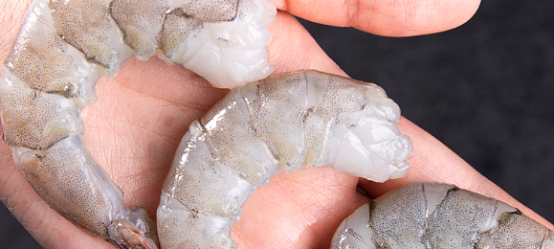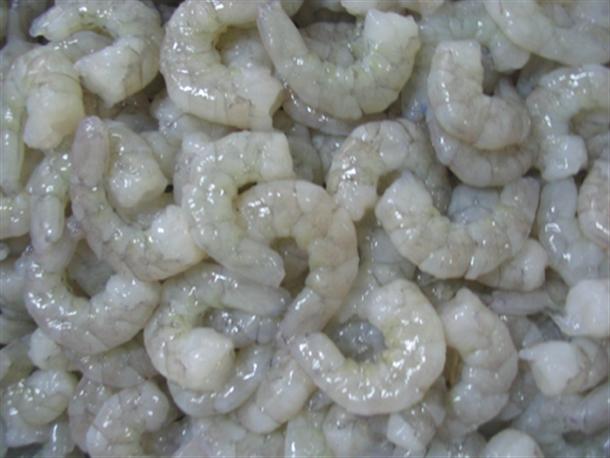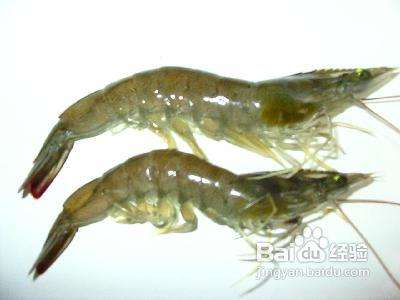South American white shrimp is one of the important domestic and export aquatic products in China. Since the promotion of large-scale aquaculture in the Hangzhou area in 2003, the corresponding frozen shrimp processing capabilities have also been growing. The main frozen processed species of South American white shrimp in this region currently include: frozen (raw) single frozen shrimp, frozen (cooked) single frozen shrimp; (Raw) frozen shrimp and shrimp meat products, this series of products is mainly sold domestically. In the export processing products, there are still some Phoenix Tail Shrimp, Bread Shrimp, and Cooked Shrimp, but their proportion in the processing is relatively small. We have summarized the processing techniques for the above-mentioned products through years of exploration and practice.
1、 Leading (raw) block freezing processing technology
1. Process description:
Raw shrimp purchase, raw shrimp cleaning, specification grading, ice water immersion, water control, weighing, tray placement, feeding, discharging, de plating, ice coating, inner and outer packaging, refrigeration
2. Process discussion
(1) Raw shrimp procurement: All raw materials entering the factory must undergo quality and hygiene inspections, and can only be allowed to enter the processing plant after passing the inspection; For export processing enterprises, all raw materials should come from export registered breeding bases. But more importantly, before the processing season arrives, the factory should send some testing personnel to some breeding farms to conduct random inspections of drug residues, heavy metal residues and other indicators of the products, in order to prevent defective products from circulating in the market.
(2) Raw shrimp cleaning: After the raw shrimp enters the purchasing conveyor belt, some manpower is arranged to clean and select impurities and spoiled shrimp, and then rinse with clean water that meets hygiene standards; If conditions permit, the steam bubble flushing assembly line can be used in the end, which not only saves labor, but also deeply cleans the sludge and other debris on the shrimp head.
(3) Specification grading: Before the emergence of mechanical automatic grading machines, previous shrimp processing plants used manual grading methods; But with the increasing labor costs in China year by year, most manufacturers currently use shrimp automatic grading machines to classify South American white shrimp into different specifications. The most important thing to pay attention to during automatic grading is to prevent shrimp from jumping to different grades, that is, to prevent uneven size of the graded shrimp; At present, most manufacturers use a portion of labor at the discharge outlet of the classifier to reduce the occurrence of such phenomena. Usually, the grading capacity of a machine is around 1 ton per hour, but the grading capacity for smaller sizes will correspondingly decrease. During the grading process, attention should also be paid to adding some ice cubes to the raw material bucket of the grading machine from time to time to maintain the freshness of the shrimp quality during the sorting process.
(4) Ice water immersion: Usually, because different sizes of shrimp produced by the grading machine cannot be processed in the freezer at the same time, there needs to be a buffer storage area for the graded finished shrimp. If the workshop temperature can be controlled below 10~C, ordinary food grade plastic drums can be used; The appropriate capacity for the bucket is around 600-1000 liters. But if the temperature in the workshop is difficult to control, insulated buckets should be used to temporarily store the graded finished shrimp. However, no matter what method is used to temporarily store the shrimp, the temperature of the ice water in the bucket should be controlled below 4-6 ℃ as much as possible. If the soaking water temperature is too high, it will significantly accelerate the rate of shrimp spoilage. Normally, the soaking time should be controlled within 4 hours.
(5) Water control and weighing: Water control is a processing procedure established to minimize errors in the thawing of finished products as much as possible. Usually, ordinary food grade baskets are used as water control tools, with the weight of each basket of shrimp controlled between 15-30kg. The water control standard is usually: the shrimp in the basket can be weighed after draining until the water stops flowing. Try to use electronic scales with errors suitable for the corresponding volume of iron or plastic plates for weighing. At present, the main proportion of net shrimp weight per plate in the domestic market is between 0.6 and 2kg, so electronic scales should be selected with a maximum weight of around 5kg as much as possible. The maximum error for each interrogation during shrimp weighing should be controlled within 10-20g.
(6) Plate placement: Currently, the main tools for plate placement in China are iron plates and plastic plates. In terms of cooling effect, the former is better, but if the iron plate is not made of stainless steel, it is prone to rusting. Plastic trays have the advantages of light cost and easy transportation, but the disadvantage is that the cooling effect is relatively poor compared to iron trays. When arranging dishes, most export frozen shrimp require the top layer to be arranged in sequence, but currently there are few domestic frozen shrimp that require this. Some domestic frozen shrimp processing plants in the Guangdong and Guangxi regions also require the top layer of shrimp to be arranged in sequence. Currently, many frozen products require a food grade plastic sheet to be placed at the bottom of the tray before being placed on it, in order to facilitate easy removal and packaging in the future.
(7) Feeding: There are various types of feeding due to the diversity of refrigeration equipment, and currently two main feeding methods are used. One is more traditional, which is freezing in a freezer; Another type is flow type refrigeration equipment, such as spiral freezers or tunnel freezers. The former is more labor-intensive, and the quick freezing time is long, resulting in poor product appearance; However, due to the low investment, the production capacity can be large or small, and the electricity consumption is also lower than other quick freezing equipment. Therefore, there is still some capacity preserved in China, but the trend in the future will inevitably be replaced by flow type freezing equipment. The flow type refrigeration equipment has the advantages of small footprint, labor saving, and good speed, but the investment and power consumption are relatively high. The feeding of the quick freezing warehouse mainly relies on manual entry into the warehouse to place the shrimp arranged on the corresponding pipes. The flowing type only requires an individual to place the shrimp on the feeding port after arranging the tray.
(8) Discharging and plating with ice coating: When the central freezing temperature of the shrimp is below minus 18 ℃, it can be discharged; When discharging, the quick freezing warehouse needs to be manually entered to remove the chilled shrimp; But the flow freezing only requires picking up the goods at the discharge port. After discharging, put the frozen shrimp and dish together in ice water for about 5 seconds, then drain the water and remove the dish; The main purpose of ice coating shrimp is to prevent frozen shrimp from being stored in a cold storage for a long time, which is a step for sealing and preservation. Normally, the water temperature for ice coating should be below 4 ℃, otherwise it will cause the frozen finished product to soften and deform; At present, some manufacturers also use the water spraying method to coat ice jackets and remove trays, which saves manpower compared to the former, but also has the problem of uneven water spraying. The water used for ice coating, if possible, should be treated with purified water from water treatment equipment to further enhance the appearance and surface transparency of frozen shrimp.
(9) Packaging and warehousing: put the off tray products into plastic bags, put the finished products into cartons or foam boxes according to the specification requirements in the environment below 10 ℃, and seal the boxes with self-adhesive tape. After packing, immediately transfer the cardboard boxes to a (20 ± 1 ℃) freezer and store them according to the specified requirements.
2、 Leading (raw) single freezing processing technology
1. Process description: Raw shrimp procurement, raw shrimp cleaning, specification grading, ice water immersion, water control, feeding and discharging, ice coating, freezing once or twice, weighing, inner and outer packaging, refrigeration
2. The difference between single frozen shrimp and block frozen shrimp is that after being frozen into finished products, the block frozen shrimp are connected to each other and can only be separated after thawing. After being frozen into finished products, the shrimp bodies are not connected. This chapter will provide a detailed breakdown of the process flow and the different steps involved in the above frozen shrimp blocks.
(1) Feeding: Block frozen shrimp need to be placed on a tray before feeding, while single frozen shrimp only need to control the water before feeding. Moreover, single frozen shrimp can only be processed using flow type freezing equipment. Spread the semi-finished product after water control evenly on the mesh belt of the spiral freezer for quick freezing; Be sure to separate only the shrimp and avoid overlapping.
(2) Secondary quick freezing: After the first quick freezing by the spiral machine, the center temperature of the shrimp body reaches minus 18 ℃, and the semi-finished product enters the ice coating pool. The time should be controlled within half a minute, but the specific time needs to be combined with the target ice coating amount of each shrimp; The longer the time, the greater the amount of ice coating, but it cannot be too long, otherwise it will cause the frozen coating to thaw. After being coated with ice, the semi-finished shrimp needs to be frozen in a secondary freezer and the surface moisture of the shrimp body needs to be blown dry, otherwise it will cause adhesion and defrosting of the finished product. The refrigeration temperature inside the secondary freezer should be controlled at around minus 25 ℃. Too low a temperature can cause the ice jacket on the surface of the shrimp to crack, while too high a temperature can lead to excessive temperature at the center of the shrimp.
(3) Discharge and weighing: Shrimp that have undergone secondary rapid freezing should be packaged in a workshop at room temperature below 10 ° C, otherwise it may cause the surface ice coating to melt and the shrimp to adhere. Single frozen shrimp is usually packed in a large plastic bag and then put into a carton or foam box.
3、 Leading (cooked) single freezing processing technology
1. Process description: Raw shrimp procurement, raw shrimp cleaning, steaming, cooling, specification grading, ice water immersion, water control, feeding, discharging, ice coating, freezing, weighing, inner and outer packaging, refrigeration.
2. Process discussion
The difference between the leading (cooked) single freezing processing technology and (raw) single freezing mainly lies in the two steps of cooking the shrimp with a steamer after washing the raw shrimp and cooling the cooked shrimp with ice water. This chapter will provide a detailed breakdown of the process flow and the asynchronous steps of the leading (raw) single freezing mentioned above.
(1) Steaming and Cooking: Currently, the main energy sources for steaming and cooking machines are electricity and boilers. Compared to other methods, using boilers for steaming and cooking is relatively stable and common. There are also two types of steaming carriers: hot water and steam, the latter of which is easy to maintain the nutritional content in shrimp. Control the temperature between 98-100 ° C during steaming and boiling; The cooking time should be controlled at around 2 minutes. After steaming and boiling, it is transported to the spray point of normal temperature water and then enters the normal temperature cooling pool. If there is a deviation in temperature and time during cooking, it should be adjusted in a timely manner and tested before re cooking can be carried out.
(2) Cooling: After steaming and cooking, the semi-finished product can be cooled at a constant temperature and then immersed in a 4~C ice bucket to quickly reduce the temperature of the shrimp body to below 10 ℃ for grading.
(3) Regarding cooked shrimp: Currently, both domestic and international markets have high quality requirements for cooked shrimp, and there should be no occurrence of blackheads or other quality issues. Therefore, in the process of cooking shrimp, the most crucial thing is acquisition. At present, most manufacturers in Hangzhou use live water transportation to purchase shrimp, which can effectively reduce the incidence of blackheads, U-turns, and other phenomena.
4、 Conclusion
Shrimp processing is an art that requires not only good product quality and taste, but also aesthetic appearance. At present, the shrimp processing products in our region mainly face competition from manufacturers in Guangdong and Guangxi regions domestically, and also face competition from shrimp breeders in Thailand, Vietnam, Indonesia, India and other countries competing for the global market. But the Hangzhou region has abundant natural resources and support from the public sector. The shrimp industry in our region will continue to develop and provide high-quality services to the national and even global markets for a long time.






